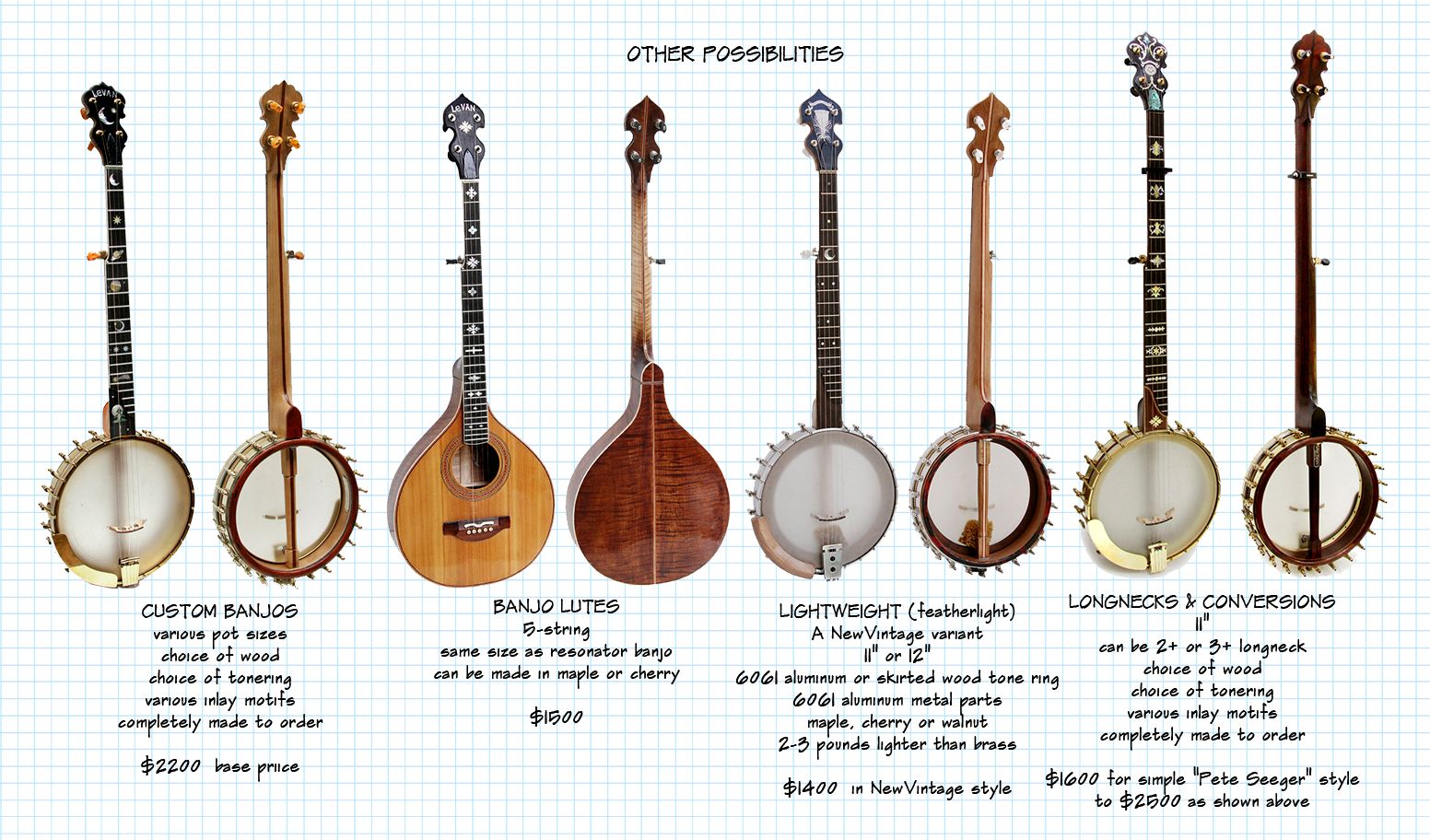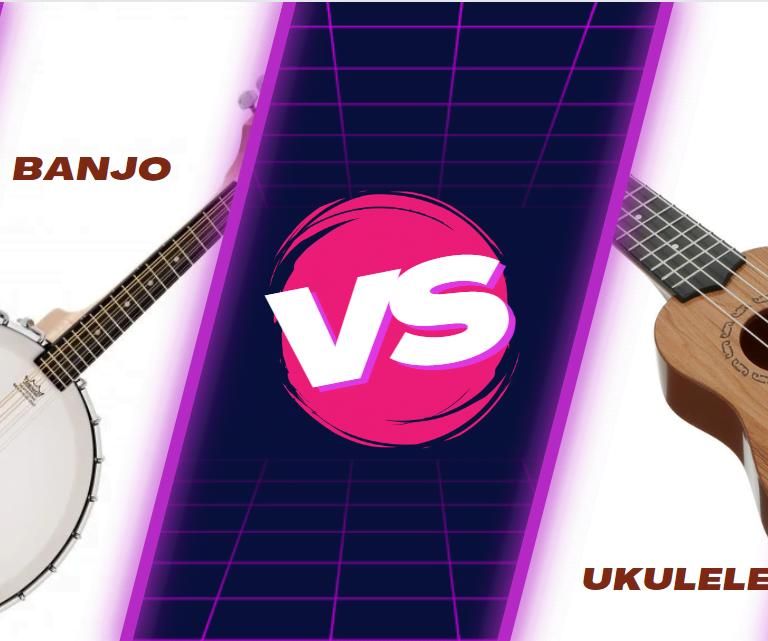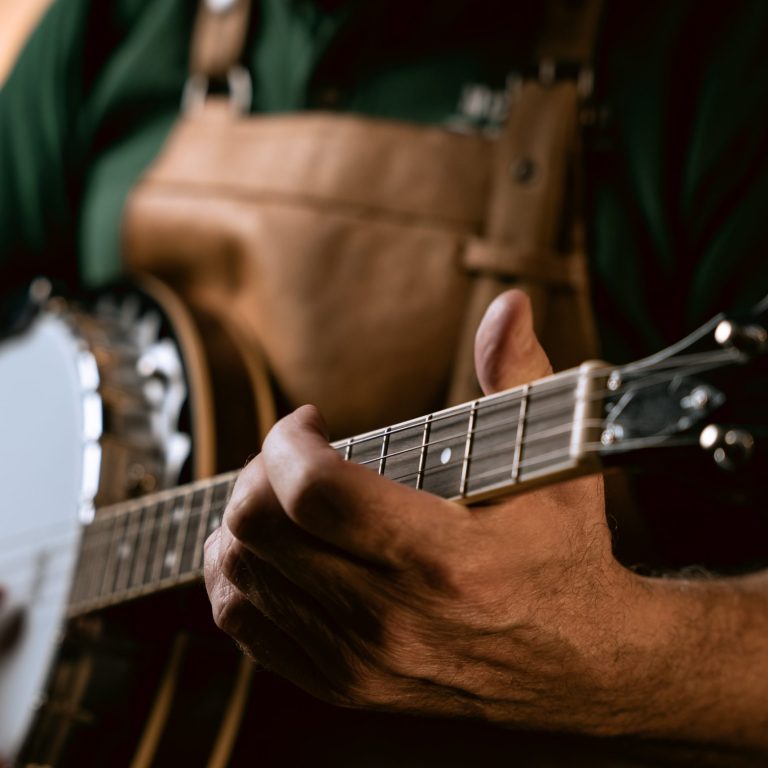There are various Types of Banjos, including 4 strings, 5 string, and 6 string variations, each with distinct features and playing styles. To select the banjo that best suits your requirements, it is essential to have a solid understanding of the different types of banjos.
Having a solid understanding of the distinctions between these many sorts of banjos is essential for ch.It is possible to experiment with a broad variety of possibilities, ranging from the classic five-string bluegrass banjo to the distinctive four-string tenor banjo, which has a distinctive sound. Additionally, the six-string banjo provides a hybrid experience, which is intriguing to guitarists who are interested in incorporating banjo tones into their artistic compositions.picking out the instrument that best suits your requirements.
Each variety of banjo possesses its own distinct personality, tone, and versatility, which enables it to be utilized in a wide range of musical styles and playing approaches. Have a thorough awareness of the many sorts of banjos, regardless of whether you are just starting out or have years of experience playing the instrument. This will allow you to make an educated choice when choosing your instrument.
Table of Contents
Evolution Of Banjos
In the course of our investigation into the long and illustrious history of banjos, it is exciting to investigate the development of this well-known instrument. Since its birth, the banjo has been subjected to a number of significant alterations, which has resulted in the development of a variety of different types and styles. In this article, we will take a more in-depth look at the development of banjos, beginning with their beginnings in Africa and then moving on to the transition that they went through in the United States.
Origins In Africa
The origins of the banjo can be traced back to West Africa, where similar instruments existed for centuries. These early prototypes were crafted from gourds or hollowed-out wood, with strings made of sinew or plant fibers. The rhythmic and melodic qualities of these instruments were brought to the Americas through the transatlantic slave trade. Over time, the design and construction of the banjo evolved, incorporating elements from various African musical traditions.
American Transformation
In the United States, the banjo underwent a significant transformation, particularly during the 19th century. Influenced by European and Native American musical styles, the banjo was refined and reimagined, leading to the creation of distinct American banjo styles such as the minstrel banjo, which became popular in the 19th century. These developments laid the foundation for the modern banjo as we know it today, with its unique blend of African and American influences.
Anatomy Of A Banjo
When it comes to understanding the different types of banjos, it’s essential to start by exploring the anatomy of this unique instrument. Each part plays a crucial role in the overall sound and functionality of the banjo, making it important for musicians and enthusiasts to familiarize themselves with its components. Let’s delve into the anatomy of a banjo by examining the pot and resonator, neck and fingerboard, headstock and tuners.
Pot And Resonator
The pot and resonator are important to the design of a banjo and substantially impact its tone and projection. The pot consists of the rim, tension hoop, and head, which collectively constitute the drum-like body of the banjo. While open-back banjos normally do not have a resonator, ones meant for bluegrass music incorporate a resonator, a spherical, flat-backed shell affixed to the back of the pot. This feature functions as a sound chamber, reflecting and pushing the banjo’s sound forward, resulting in a distinct, forceful presence, characteristic of bluegrass banjos.
Neck And Fingerboard
The neck and fingerboard are critical elements that contribute to the playability and sound of a banjo. Crafted from durable woods such as maple or mahogany, the neck attaches to the pot and provides support for the strings and tuners. The fingerboard, typically made of ebony or rosewood, is where the player positions their fingers to produce different notes and chords. It plays a significant role in the articulation and clarity of the banjo’s sound, allowing for precision and expression during performances.
Headstock And Tuners
The headstock of a banjo is where the tuners are located, allowing the player to adjust the tension of the strings to achieve the desired pitch. The design and arrangement of the headstock can vary between banjo models, from the traditional slotted headstock to the modern paddle-shaped headstock. Additionally, the choice of tuners, whether planetary or geared, can influence the ease and accuracy of tuning. A well-designed headstock and reliable tuners are essential for maintaining stable intonation and tuning, crucial for a consistent and harmonious performance.
The Types Of Banjos
One of the most intriguing aspects of banjos is their versatility. Whether you’re a folk musician, bluegrass enthusiast, or an avid lover of country music, there’s a banjo that suits your style and playing preferences. From the timeless 4 string banjo to the popular 5-string banjo and the unique 6-string banjo, each type offers its own distinct sound and playing possibilities.
4 string Banjo
The 4 string banjo, also known as the tenor banjo, is widely used in traditional jazz, Celtic, and Dixieland music. Equipped with a shorter neck and 17 frets, this banjo produces a crisp and bright tone. Its compact size and distinctive sound make it a popular choice for musicians who appreciate its unique timbre and versatility across various musical genres.
5 string Banjo
The 5 string banjo is the most common type, featuring a resonator and an open back. With its versatile and distinctive sound, the 5 string banjo is an essential instrument in bluegrass, old-time, and folk music. Whether played with fingerpicking or using a clawhammer technique, the 5 string banjo offers a wide range of tonal possibilities, making it a staple in many musical compositions and performances.
6 string Banjo
The 6 string banjo, often referred to as the guitar banjo, combines the playing style of a guitar with the resonant sound of a banjo. This innovative instrument appeals to guitarists seeking a unique sound while retaining the familiarity of a six-stringed instrument. With its hybrid nature, the 6 string banjo opens up new possibilities for experimentation and creativity, positioning itself as a versatile tool for musicians seeking to explore uncharted musical territories.
Bluegrass Banjos
Bluegrass banjos are a popular choice for musicians playing the fast-paced and energetic bluegrass music genre. These banjos are known for their distinct bright and crisp sound, making them well-suited for the lively and rhythmic playing style typically associated with bluegrass music.
Characteristics And Use
Bluegrass banjos are often characterized by their resonator backs, which project sound forward, providing a louder and more powerful tone. The resonator, typically made of wood, enhances the banjo’s volume and projection, making it ideal for playing in band settings and live performances. In addition, bluegrass banjos typically feature a tightly drumhead that produces the signature bright and aggressive sound that cuts through the mix of other instruments.
In terms of use, bluegrass banjos are commonly played in the context of a bluegrass band, providing the driving rhythms and punchy accents essential to the sound of the genre. Their bright and lively tonal characteristics also make them suitable for solo performances, as they can stand out and carry a tune effectively.
Notable Bluegrass Banjo Players
Several influential musicians have made their mark on the bluegrass banjo, shaping the sound and techniques associated with the instrument. Some notable bluegrass banjo players include:
- Earl Scruggs: Renowned for his innovative three-finger picking style, Earl Scruggs revolutionized banjo playing, making significant contributions to the development of bluegrass music.
- J.D. Crowe: Known for his dynamic and expressive banjo playing, J.D. Crowe has been a pivotal figure in bluegrass music, influencing generations of banjo players.
- Sammy Shelor: As the leader of the Lonesome River Band, Sammy Shelor has showcased his remarkable banjo skills, earning accolades for his virtuosic playing.
Jazz Banjos
When it comes to banjos, the world of jazz has its own unique charm and flair. Jazz banjos are special instruments that bring a distinctive rhythm and melody to the genre. They possess unique features and a sound that sets them apart from other types of banjos. Renowned jazz banjo musicians have contributed to the popularity and recognition of these instruments in the world of jazz music.
Unique Features And Sound
Jazz banjos, also known as plectrum banjos, are characterized by their shorter necks and four-string configuration, making them suitable for chordal and melodic playing. These banjos typically have a resonator, which enhances their volume and projection, ideal for the lively and upbeat nature of jazz music. The shorter scale length of jazz banjos contributes to a brighter and punchier sound compared to other banjo types. Additionally, jazz banjos are commonly played with a pick, producing a sharp and articulate tone that complements the fast-paced nature of jazz music.
Renowned Jazz Banjo Musicians
- Danny Barker: A legendary jazz banjoist known for his contributions to traditional New Orleans jazz.
- Eddie Peabody: A prolific plectrum banjo player who popularized the instrument in the early 20th century through his recordings and performances.
- Carl Jackson: An accomplished musician who has showcased the versatility of the jazz banjo in various jazz subgenres.
Folk Banjos
The folk banjo holds a significant place in the history and tradition of folk music. It has been integral to the creation and preservation of various folk music styles, contributing to rich and diverse cultural traditions. The Folk banjos have evolved to represent the unique characteristics of different regions and communities, each style carrying its own distinct sound and playing technique.
Folk Music Traditions
Folk music traditions have roots in the cultural heritage of various communities, with each tradition contributing to the diverse landscape of folk music. From the Appalachian region of the United States to the Celtic music of Ireland and Scotland, folk music encompasses a wide array of styles, each with its own distinct characteristics and cultural significance. The folk banjo has played a crucial role in shaping and embodying these diverse traditions, adding a layer of authenticity and depth to the folk music landscape.
Prominent Folk Banjo Styles
Prominent folk banjo styles have emerged from different regions and cultural contexts, each style reflecting the unique musical heritage and playing techniques of the community. Some notable folk banjo styles include:
- Appalachian Clawhammer: Known for its rhythmic and melodic qualities, this style employs a down-picking motion and intricate finger movements, creating a distinctive sound that is deeply intertwined with Appalachian folk music.
- Celtic Frailing: Characterized by its lively and energetic rhythms, Celtic frailing incorporates quick strumming and plucking techniques, reflecting the spirited nature of Celtic folk music.
- Bluegrass Three-Finger: Originating in the bluegrass music tradition, this style features rapid picking patterns and complex fingerings, contributing to the lively and vibrant spirit of bluegrass music.
- Old-Time Stroke Style: This traditional style focuses on the use of a rhythmic strumming motion, producing a percussive and driving rhythm that perfectly complements the old-time folk music repertoire.
Banjo Innovations
The banjo, with its roots tracing back to West Africa, has undergone various innovations over the years. These innovations have led to the development of unique types that cater to different musical styles and preferences. Among these innovations are electric banjos and hybrid banjos, each offering distinct features and sounds to cater to a wide range of musicians and audiences.
Electric Banjos
Electric banjos have gained popularity in contemporary music, especially in genres like rock, jazz, and fusion. These banjos are equipped with electromagnetic pickups, allowing them to be amplified and produce a louder, distinct sound. The incorporation of electric components also opens up a myriad of sound modulation possibilities, making them versatile instruments for modern musicians.
Hybrid Banjos
Hybrid banjos amalgamate traditional banjo designs with elements from other stringed instruments, such as guitars or mandolins. This fusion results in a hybrid instrument that blends the unique tone of the banjo with the playability and characteristics of other string instruments. Musicians can experiment with different playing techniques and musical styles, creating a harmonious blend of sounds that resonate with diverse audiences.
Choosing The Right Banjo
When it comes to choosing the right banjo, it’s crucial to consider various factors to ensure it’s the perfect fit for your needs. Whether you’re a beginner just starting or an experienced player looking to upgrade, finding the right banjo can significantly impact your playing experience.
Considerations For Beginners
If you’re a beginner looking to purchase your first banjo, there are a few key considerations to keep in mind. The type of music you want to play can influence the type of banjo you choose. For bluegrass, a resonator banjo is often preferred, while for folk and old-time music, an open-back banjo may be the better option. The number of strings is also a crucial factor – traditional five-string banjos are popular among beginners, but four-string and six-string banjos are also available. Comfort and playability are essential, so it’s advisable to try different banjos to determine which style and neck width feel best for you.
Finding The Perfect Fit
Ensuring that the banjo fits your style and preferences is paramount. Consider the tone and sound you desire – different banjos produce varying levels of brightness, warmth, and sustain. The build quality and materials used can also impact the overall sound and durability of the instrument. Budget and brand reputation should also be taken into account when making your selection. Ensure that the banjo not only meets your current needs but also allows room for growth as you progress in your playing.

Credit: Pinterest
Frequently Asked Questions Of Different Types Of Banjos
What Are The Different Types Of Banjos?
Banjos come in various types, including 4 string, 5 string, and 6 string models. Each type produces a unique sound and is suited for different styles of music, from bluegrass to folk.
Which Type Of Banjo Is Best For Beginners?
For beginners, a 5 string banjo is recommended due to its versatility and popularity in various music genres. It offers a balance between traditional and modern playing styles, making it ideal for learning the instrument.
What Is The Difference Between Open-back And Resonator Banjos?
Open-back banjos have a mellower tone and are often used in folk and old-time music. Resonator banjos, with their louder and brighter sound, are preferred for bluegrass and country music, offering greater projection and clarity.
Can A Banjo Be Used To Play Different Genres Of Music?
Yes, banjos are versatile instruments suitable for various music genres, including bluegrass, folk, country, and even rock. The type of banjo and playing style can be adapted to accommodate different musical preferences and styles.
Banjos come in various types, each with its unique sound and style. Whether it’s the traditional five-string banjo or the more contemporary six-string banjo, there’s a type that suits every player’s preference. Understanding these differences can help you find the perfect banjo to match your musical aspirations.
Explore the possibilities and find the banjo that resonates with you. To check our more blogs Click Here



